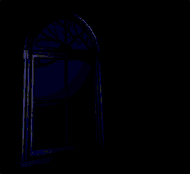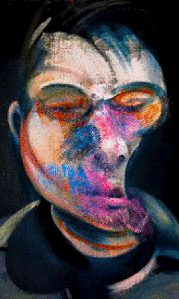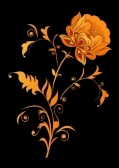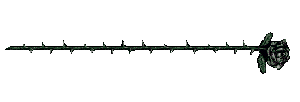Against all odds
KING OF HORROR
As a child, King apparently witnessed one of his friends being struck and killed by a train, though he has no memory of the event. His family told him that after leaving home to play with the boy, King returned, speechless and seemingly in shock. Only later did the family learn of the friend’s death. Some commentators have suggested that this event may have psychologically inspired some of King’s darker works, but King makes no mention of it in his memoir On Writing.
 King’s primary inspiration for writing horror fiction was related in detail in his 1981 non-fiction Danse Macabre, in a chapter titled “An Annoying Autobiographical Pause”. King makes a comparison of his uncle successfully dowsing for water using the bough of an apple branch with the sudden realization of what he wanted to do for a living. While browsing through an attic with his elder brother, King uncovered a paperback version of an H. P. Lovecraft collection of short stories entitled The Lurker in the Shadows that had belonged to his father. The cover art—an illustration of a yellow-green Demon hiding within the recesses of a Hellish cavern beneath a tombstone—was, he writes, the moment in his life which “that interior dowsing rod responded to.” King told Barnes & Noble Studios during a 2009 interview, “I knew that I’d found home when I read that book.”
King’s primary inspiration for writing horror fiction was related in detail in his 1981 non-fiction Danse Macabre, in a chapter titled “An Annoying Autobiographical Pause”. King makes a comparison of his uncle successfully dowsing for water using the bough of an apple branch with the sudden realization of what he wanted to do for a living. While browsing through an attic with his elder brother, King uncovered a paperback version of an H. P. Lovecraft collection of short stories entitled The Lurker in the Shadows that had belonged to his father. The cover art—an illustration of a yellow-green Demon hiding within the recesses of a Hellish cavern beneath a tombstone—was, he writes, the moment in his life which “that interior dowsing rod responded to.” King told Barnes & Noble Studios during a 2009 interview, “I knew that I’d found home when I read that book.”
Related articles
- STEPHEN KING on Writing, Scary Stories, and More (writingtipsforbetterwriting.wordpress.com)
- Review: On Writing (Stephen King) (charlotteunsworth.wordpress.com)
- The Gunslinger by Stephen King (King’s Revised Addition) (thesciencefictionandfantasyreview.com)
- Quotes for Writers (and people who like quotes) STEPHEN KING (bridgetwhelan.com)
- Is horror making a come back? (poll) (creativityuntamed.com)
- Your Guide to HNR’s Inaugural ‘Stephen King Appreciation Day’! (horrornovelreviews.com)
- Authors pay tribute to James Herbert (bbc.co.uk)
- The Grand Stephen King Experiment: Tales From The Darkside The Movie(1990) (tannerwillbanks.wordpress.com)
- The Passing of a True Master of Horror (thehorrificallyhorrifyinghorrorblog.com)
- influences in horror (quillotine.com)
- Your Guide to HNR’s Inaugural ‘Stephen King Appreciation Day’! (horrornovelreviews.com)
- Authors pay tribute to James Herbert (bbc.co.uk)

Related articles
- Stephen King Biography (delightandfear.wordpress.com)
FEAR
PSYCHOLOGY OF FEAR
- “Have you ever wondered how someone like Edgar Allan Poe wrote as he did long before the genre of horror even existed? By studying and life and times of this great American writer, considered by many to have been the first “terrorist of the imagination,” one can come to understand his extremes as a writer. Better yet, listen to what Poe himself had to say about the psychology of fear, first published in his Marginalia for June of 1849, four months before his tragic death: “The grim legion of sepulchral terrors cannot be regarded as altogether fanciful, but like. . . Demons. . . they must sleep, or they will devour us—they must be suffered to slumber, or we perish.” 1
- Exactly what does Poe mean by this remark? “Sepulchral,” a reference to a mortuary or funeral, overflows with the terrors of the unknown as they relate to death and dying; “Demons” are obviously the foundation of this funerary terror, entities which must “sleep” and “slumber” in the darkness of death or else “devour us” with their terrors. In essence, Poe is metaphorically stating that if these “Demons” are unleashed, man will become submerged in the oldest emotion known to him, namely, a sense of unbounded fear.”
Source:
-
- Edgar Allan Poe Museum (Richmond, Virginia) (Photo credit: Wikipedia)
- Sometimes
fear is learned from someone else,
such as a child who is afraid of snakes because of her mother’s reactions.
Whatever the object of fear, you may become distressed or uncomfortable when you confront that object.
If you are afraid of flying, for example, you may become jittery or anxious when you board an airplane.
You may self-medicate, perhaps by indulging in a pre -flight drink, but you are able to manage your symptoms and get on with your life. You may prefer to travel by car or train, but will fly when it is necessary or practical.
- On the other hand if you have a diagnosable phobia of a specific object or situation, your response will be more extreme. The fear of hights makes you sweat, shake, cry or have other serious physiological responses. You will likely be miserable if you do not get professional help.
Fear has many uses.
- It can be used as a warning to keep you from entering into a situation that might hurt you.
- It can be used to motivate you away from something, such as a harmful relationship or a dangerous situation.
- It can also be used by others to control you.
How do people use fear to control others?
MODERN FEAR
 When you say or do anything to please, get, keep, influence, or control anyone or anything, fear is the cause and pain is the result. When you say or do anything to please, get, keep, influence, or control anyone or anything, fear is the cause and pain is the result.  |
Imagination is a tool to be used, but how many people misuse it to torment themselves?
Imagination and emotionality are closely linked and what we imagine can feel very real to us (even when it isn’t at all).
As the author Katherine Paterson once said: “To fear is one thing. To let fear grab you by the tail and swing you around is another.”
TAKE CONTROL OF YOUR OWN MIND!!!
If you find yourself becoming overly anxious, calm down and start to regain control.
- Don’t hang around negative people or people who are being negative at the time. You don’t need to absorb their fear any more than you need to absorb the fear from the news on TV.
As you begin to emerge from the state of fear and can once again think rationally and creatively, look at how you can create unity in your life instead of the polarity caused by fear.
I am determined to be cheerful and happy in whatever situation I may find myself. For I have learned that the greater part of our misery or unhappiness is determined not by our circumstance but by our disposition.Martha Washington
The happiness of your life depends upon the quality of your thoughts: therefore, guard accordingly, and take care that you entertain no notions unsuitable to virtue and reasonable nature.Marcus Aurelius
LINKS:
- http://phobias.about.com/od/symptomsanddiagnosis/a/fearorphobia.htm
- http://www.uncommonhelp.me/articles/overcome-fear-and-anxiety/

Related articles
- Analysis on the Poem “Annabel Lee” by Edgar Allan Poe (yourlovepills.wordpress.com)
- It’s Okay To Write About Your Demons (pittsburghflashfictiongazette.com)
- Literature-gothic Elements (2012yearbookblog.wordpress.com)
- Gothic Elements (2012yearbookblog.com)
- Fear, Human’s Biological Emotion And How I Would Love To Control It (chainringaction.blogspot.com)

- Go Ahead, Stop Blaming Everyone Else For Your Fears… (acupfulofhope.wordpress.com)
- What do I fear?… (nicolascanon.wordpress.com)
- Overcoming Fears (directtogirl.wordpress.com)
- FEAR & Submission (thymastersbitch.wordpress.com)
- How To Overcome Any Fear (realrest.wordpress.com)

Related articles
- Phobias, Conquer Them. (arwinslife.wordpress.com)
- Top 5: Best short stories (jdobyrnewriter.wordpress.com)
- World of Fear and Terror (azizalshebaiky.wordpress.com)
- Friday’s Top Fives: Authors of Horror (dreameras.wordpress.com)
- Freedom From Fear (drjotorres.com)
- Defining the Fears (lcostea.wordpress.com)
- Fear isn’t “real” (soulveritas.com)
- Fear is not REAL (dheerajgautam.wordpress.com)

- Removing Thorns (bepaulin.wordpress.com)
GOTHIC LITERTURE
GOTHIC NOVELS
The Gothic begins with later-eighteenth-century writers’ turn to the past.
In the context of the Romantic period, the Gothic is, then, a type of imitation medievalism.
When it was launched in the later eighteenth century, The Gothic featured accounts of terrifying experiences:
In ancient castles — experiences connected with subterranean dungeons, secret passageways, flickering lamps, screams, moans, bloody hands, ghosts, graveyards, and the rest.
By extension, it came to designate the macabre, mysterious, fantastic, supernatural, and, again, the terrifying, especially the pleasurably terrifying, in literature more generally.
Closer to the present, one sees the Gothic pervading Victorian literature (for example, in the novels of Dickens and the Brontës), American fiction (from Poe and Hawthorne through Faulkner), and of course the films, television, and videos of our own (in this respect, not-so-modern) culture.
Horace Walpole was it’s chief initiator, publishing The Castle of Otranto (1764), a short novel in which the ingredients are a haunted castle, a Byronic villain (before Byron’s time — and the villain’s name is Manfred!), mysterious deaths, supernatural happenings, a moaning ancestral portrait, a damsel in distress.
The best-selling author of the genre (Ann Radcliffe), the author of its most enduring novel (Mary Shelley), and the author of its most effective send up (Jane Austen) were all women.
LINKS:
- http://www.wwnorton.com/college/english/nael/romantic/topic_2/welcome.htm
- http://melissaelmes.blogspot.ro/2007/07/what-is-gothic-literature.html
- http://www.goodreads.com/shelf/show/gothic-literature?
Related articles
- Literature-gothic Elements (2012yearbookblog.wordpress.com)
- Guest: Patty Henderson (slipintosomethingvictorian.wordpress.com)
- Gothic Literature: An Introduction (queerfear.wordpress.com)
- Phantasmagoria – The Eighteenth Century Horror Show (hauntedpalaceblog.wordpress.com)
- Debating Goth in a Castle: A Dispatch From the Gothic: Culture, Subculture, Counterculture Conference (vol1brooklyn.com)
- Gothic at Strawberry Hill (cultureandanarchy.wordpress.com)
- Gothic Elements (2012yearbookblog.com)
- The Victorian Gothic – Briefel (cityfantasy.wordpress.com)
- Monstrous Vintage Covers of Mary Shelley’s ‘Frankenstein’ (flavorwire.com)
- The Madman’s Daughter Gothic Horror Writing Contest (novelnovice.com)





